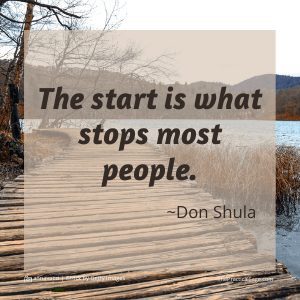“Where do I even start?” Have you ever uttered those words when you thought about changing roles, shifting your career, or even just escaping the job you currently have? I know I have. My client, Jane (not her real name), felt frustrated and exhausted, like so many clients before her. She knew she wasn’t happy in her current role, but she also didn’t know what else she might do or how she would figure it out. How do you build your path?
“There are things about this job I really enjoy,” Jane said. “I believe in the products, and I love working with my team. The people are wonderful.” Jane had interviewed with other companies in the area, but they all had their issues. “Any job or company is going to have drawbacks,” she rationalized. “How do I know any of them would be any better?”
“So, you’re going to stick with ‘the devil you know,’” I said. It was a statement more than a question.
“I guess so,” she conceded. “Plus, the money is really good.”
“They wouldn’t call them golden handcuffs if it was easy to walk away,” I smiled.
I would say I was surprised by the number of people with whom I have had this conversation, if I hadn’t also had this conversation with myself too many times to count. How is it possible that so many of us are this frustrated or unhappy about our jobs, especially when we spend so much of our lives at work?
Tailor the Job to Fit You (Not the Other Way Around)
Maybe being unhappy at work is just the reality we’ve come to expect. As humans, we adapt to our environments. The process is called “habituation.” The word sounds ominous, but it really means that we just stop noticing or even expecting something different when we experience the same thing over and over and over again. (Come to think of it, that sounds more depressing than ominous.) In some situations, adapting is a good thing. For example, when we’re in a noisy office environment (even if now that’s mostly our “home office”), we learn to tune out a lot of the repetitive ambient noise to concentrate on our work. But what happens when we just continue to adapt to a situation or environment that really isn’t a good fit? Why don’t more of us take the leap to get out of jobs or environments that aren’t working for us?
One of the biggest problems is we’re going about the process all wrong. We start looking at the macro level of the situation and work from the outside in. We look at the companies and the job postings, and we try to determine our fit with what we see available. Then, we tailor ourselves (e.g., talents, skills, and experiences) to fit what we think the employers want. But before we start rearranging our resume and LinkedIn profile to look like the “perfect candidate” for 100 different roles, how do we know what we want and what would be a great fit for who we are?1
We need to take a different approach and start at the micro level and focus on the inside first. We need to start by understanding our fundamental building blocks: values, strengths, interests, and motivations. Once we have better insight and understanding into who we are, what we’re good at, and what’s important to us, then you can use that information to build your path forward. Rather than the job becoming “the goal,” the job becomes the next step as part of our individual journey.
Start with What You Know
Sounds great, but (again), “Where do I even start?” How do we figure out our building blocks? There are great assessments to help us identify our strengths, weaknesses, values, etc. Whether we’re looking at our leadership style, individual strengths, or even how we operate as a team, I have used a number of tools with my clients based on their specific objectives. But even before we look at more formal assessments, take some time to really stop, reflect, and debrief, and focus first on what you already know about yourself. Try this exercise I call, “Best, Worst, & Better.”
Best, Worst, & Better
Take time to reflect on the following, and write down your answers:
Step 1 – Break Down Your Best: Think of at least 2-3 times when you felt the most engaged, energized, and excited about work you were doing. Maybe you were at your job, or maybe you were working in another area of your life (e.g., working around the house, coaching your kids’ game, engaging in a hobby, etc.). In each of these situations start to dig down into the building blocks of what made the experience so great. Ask yourself questions like the following:
- What did I love most about what I was doing, and why?
- What was important to me about what I was doing?
- What strengths, skills, and talents did I use in the process?
- What interested or motivated me most about what I was doing?
- What was most satisfying to me about the work, the process, and/or the results?
Step 2 – Break Down Your Worst: Now think of at least 2-3 times when you felt the most miserable, disengaged, and/or deflated about work you were doing. Again, break it down into the individual building blocks of what made it such a negative experience. Ask yourself questions to look at the opposite of how you looked at your “Best” moments:
- What did I hate most about what I was doing, and why?
- What stood out as the most negative part of this experience?
- How did this work tap into my weaknesses (rather than my strengths)?
- What was most boring, frustrating, and/or discouraging to me about this work?
Step 3- Break Down Your Better: Finally, take a look at your “Worst” list and now flip it 180 degrees by asking, “What would have made this better?”
- For example, let’s say you love working with numbers and solving problems from the ground up, but you were given a project with limited information. As a result, you struggled to understand the objectives, and how the different parts of the project fit together to create a solution. If you ask yourself, “What would have made this better?”, you might come up with things like, “Having a clear high-level view of the problem, understanding how my work fit into the broader context, knowing the different stakeholders who were involved, and clearly understanding the objectives we needed to achieve.”
The question, “What would have made this better?” may unearth some of the same factors that contributed to your “Best” situations, but it also may unearth new and important pieces that didn’t show up the first time around.
Step 4 – Find Your Themes. Once you’ve written out your answers, take a step back and start to look for themes:
- When are you at your best?
- What’s most important to you?
- What are things you won’t tolerate?
Maybe you find you’re at your best when you’re working with people, or maybe you prefer to work with numbers. Maybe you find you don’t like to work in isolation, or maybe you’re highly intolerant of too many interruptions. Maybe you prefer being strategic, hands-on, or some combination of the two. There are no right or wrong answers. There’s just you: who you are, what’s important to you, and what you really want.
Step 5 – Pile Up Your Building Blocks. Finally, create two columns on a document or a spreadsheet. The header of the first column is, “What I want.” The header of the second column is, “What I don’t want.” Congratulations! You’ve begun to identify your building blocks to build your path forward.
This is not the end. In fact, it’s just the beginning, but you have answered the first very important question: “Where do I even start?” You start here. You start with what you know. You start with You.



